Types of Buckthorns: Common, Glossy, and Fine Line Buckthorns (Pictures) – Identification Guide
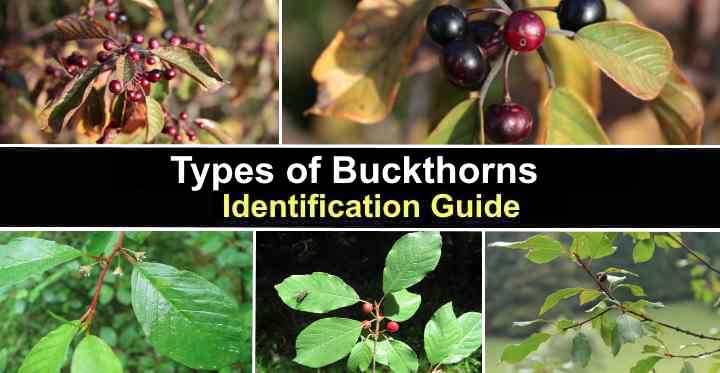
Buckthorns are a group of popular shrubs and small trees known for their vibrant foliage, thorny branches, yellow-green or whitish-green flowers, and black berry-like drupes. The ornamental shrubs are found throughout North America. Identifying types of buckthorns is vital because some non-native varieties, like the common buckthorn, are invasive and choke out native species.
This article provides an identification guide to different types of buckthorn plants. Descriptions and pictures of various species of common buckthorn trees and shrubs will help you identify these plants and understand their characteristics and uses in landscaping.
Buckthorn Facts
Buckthorn (Rhamnus spp.) is a diverse genus of small trees and shrubs with over 140 species found worldwide. Characteristic features of buckthorn shrubs are their deciduous leaves, woody spines, yellowish-green star-shaped flowers, and dark-colored fruits. Notable for their adaptability to various habitats, some non-native buckthorn species are invasive, disrupting ecosystems.
Buckthorn berries are inedible because they cause stomach cramping and diarrhea. Because the black berry-like drupes look like aronia, sand cherries, and elderberries, identifying buckthorn trees and shrubs is vital.
Distinguishing Native Buckthorn from Invasive Buckthorn
Differences between common buckthorn and native species are the thorns, height, and flowers.
For example, native buckthorn, alderleaf buckthorn (Rhamnus alnifolia), is a small spreading shrub growing up to 8 ft. (2.4 m). In contrast, non-native buckthorns are small trees growing 23 to 25 ft. (7 – 7.6 m) tall. Also, native buckthorns are thornless shrubs, whereas the common buckthorn has sharp spines.
Additionally, introduced species of buckthorn have small flowers with petals; however, native buckthorns have petal-less flowers.
Impact of Invasive Buckthorn
The two lookalike invasive species are common buckthorn (Rhamnus cathartica) and glossy buckthorn (Rhamnus frangula). These are invasive because of their prolific berry production, rapid growth, and adaptability to diverse environments. Common buckthorn outcompetes native vegetation, disrupting ecosystems and reducing biodiversity in North America.
Types of Buckthorns (with Pictures) and Identification Guide
Let’s look in detail at the identifying features of buckthorn shrubs and trees.
Common buckthorn (Rhamnus cathartica)
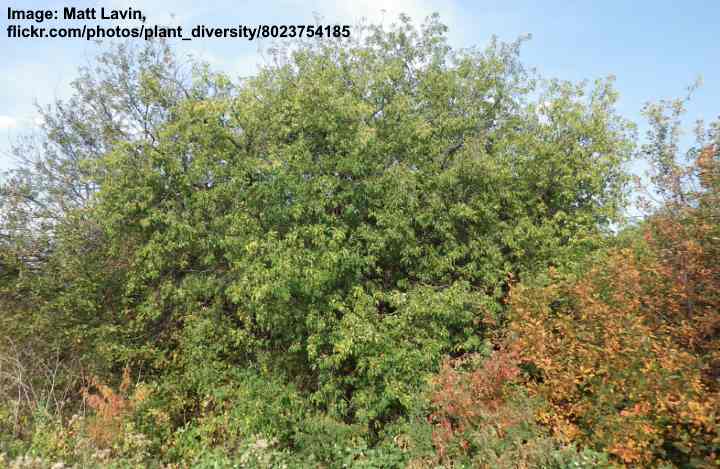
Common buckthorn is a deciduous shrub or small tree noted for its dark green, oval-shaped leaves, small five-petalled greenish-yellow spring flowers, and clusters of purple-black fruits when ripe. Growing as a small tree, common buckthorn reaches 18 to 30 ft. (5.5 – 9 m) tall.
Common buckthorn thrives in full sun or shade and tolerates moist, well-drained soils. The small tree or shrub grows rapidly from seeds, and multiple sprouts grow prolifically from underground stems. Common buckthorn thrives in USDA zones 3 to 7.
Common uses in a landscape for common buckthorn are as a hedge, windbreak, or screening plant. Its thorny stems and dense foliage help keep unwanted visitors out of yards. Also, its berries attract birds; however, the fruits are less nutritious for wildlife than other native berries.
Buckthorn Branches
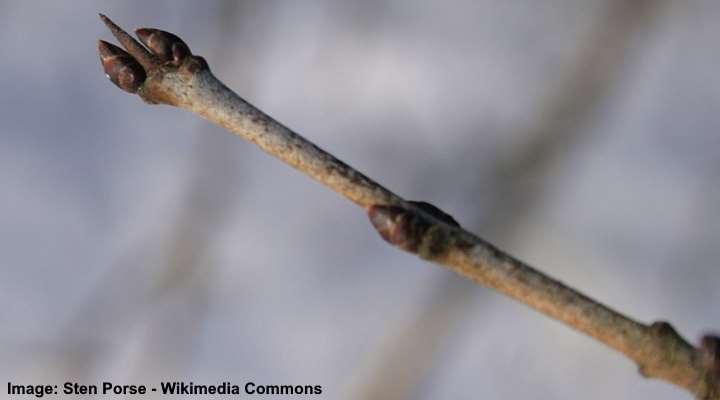
Common buckthorn branches are typically slender and grayish-brown, with small thorns. The branch tips usually contain a sharp spine with two elongated buds on either side. The thorny structure looks like a deer’s hoof, hence the plant’s common name—buckthorn.
Buckthorn Leaves
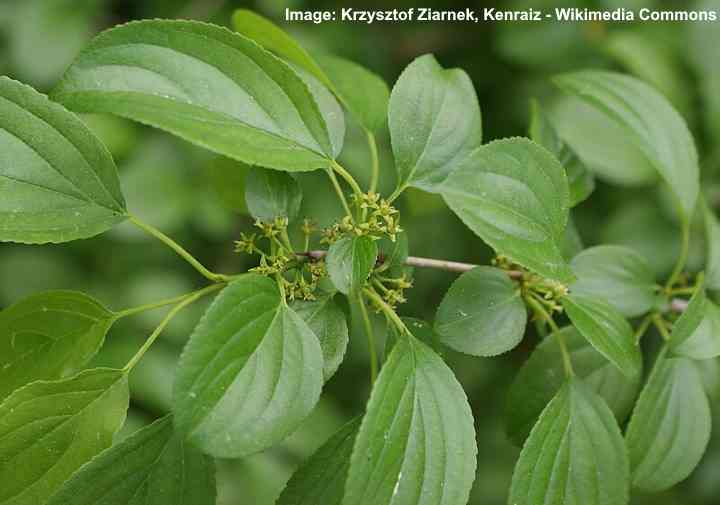
The leaves of common buckthorn are elliptical with toothed margins. The glossy green leaves measure 1.5” to 3” (3.8 to 7.5 cm) long and are arranged alternately on stems. The leaves have easily identifiable arching veins and a tapered base. Common buckthorn’s fall color is golden yellow.
Buckthorn Flowers
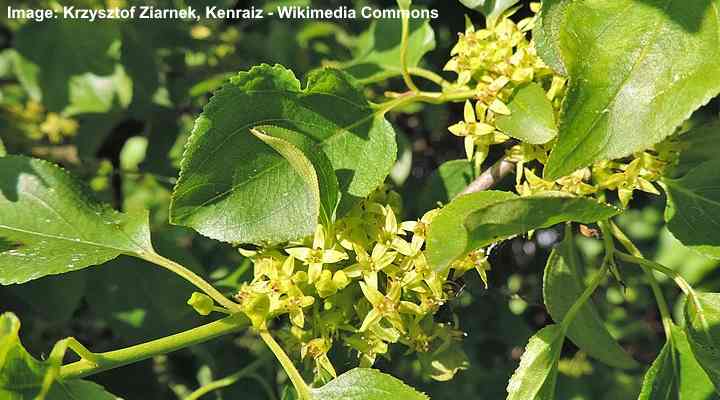
Common buckthorn flowers are small, inconspicuous clusters of greenish-yellow blossoms. The small buckthorn flowers bloom in clusters along the branches and measure 0.25” (6 mm) across. The individual flowers have five petals and are radially symmetrical. Common buckthorn blossoms in spring.
Buckthorn Fruit
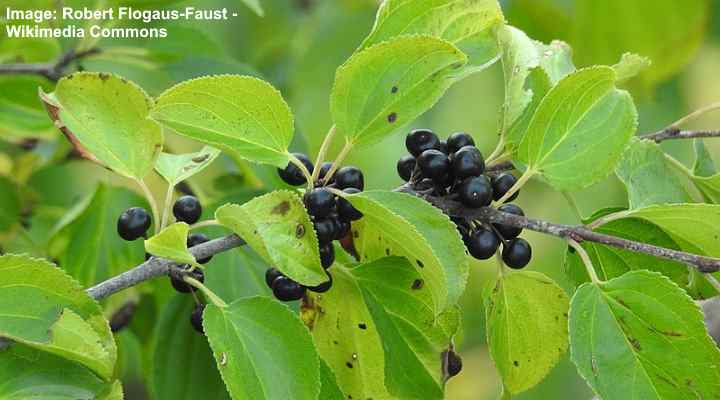
Common buckthorn fruits are small, round, berry-like drupes that emerge green and turn yellow before ripening to glossy black. These berries are typically 0.25” to 0.50” (6 to 13 mm) in diameter and contain two to four seeds each.
It’s important to note that common buckthorn berries are mildly toxic. Therefore, ingesting the berries induces a strong laxative effect and gastrointestinal upset.
Buckthorn Roots
Common buckthorn has a network of fibrous, wide-spreading shallow roots that anchor the shrub into the soil. Suckers commonly sprout from the roots, causing the species to become invasive.
How to identify common buckthorn
The common buckthorn is identified by its slender branches tipped with small thorns, dark green, glossy, ovate leaves with serrated edges, and inconspicuous yellowish-green flower clusters. In the fall, small, shiny black berries appear. The large shrub or small tree grows 18 to 30 ft. (5.5 – 9 m) in height.
Glossy Buckthorn (Frangula alnus / Rhamnus frangula)
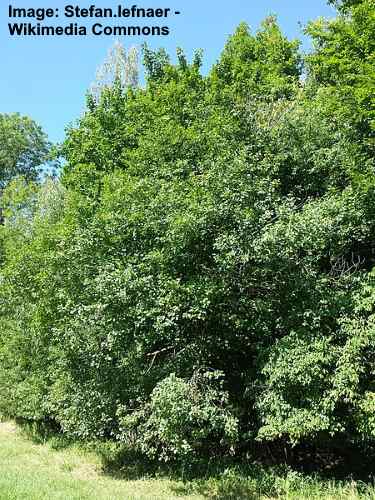
Glossy buckthorn, also called alder buckthorn, is a sun-loving shrub with smooth, thornless branches, green oblong leaves, and red to purple-black berry-like drupes. Native to Europe, glossy buckthorn has a suckering habit, forming dense thickets. The invasive shrub grows 10 to 16 ft. (3 – 5 m) tall.
Glossy buckthorn thrives in USDA zones 2 through 7 in full sun and loamy soil with good drainage. The shrub’s dense nature makes it a landscape solution as a border, hedge, privacy screen, or foundation planting. You can also grow glossy buckthorn as a tree by removing its suckers.
Like common buckthorn, alder buckthorn spreads rapidly, quickly outcompeting native plants. Also, its glossy purplish-black fruits have low toxicity levels and can cause vomiting, nausea, and diarrhea if consumed.
Buckthorn Branches
Glossy buckthorn branches are smooth, brownish green, or reddish-burgundy without thorns. A characteristic feature of the branches is the abundant white lenticels on young brown branches. Green foliage covers the branches from spring through fall. The bark is light gray and turns darker with a rough texture as it ages.
Buckthorn Leaves
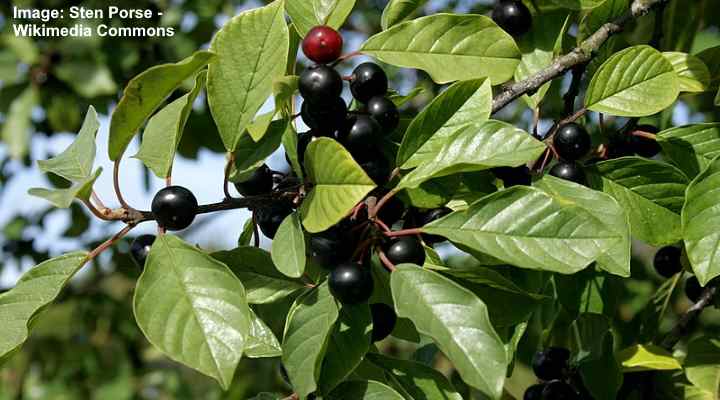
Glossy Buckthorn leaves and fruit
Glossy buckthorn leaves are dark green and oblong with smooth margins. The lustrous dark green leaves measure 1” to 3” (25 – 75 mm) long and 0.5” to 1.5” (13 – 38 mm) wide. Leaves are arranged alternately and oppositely along the stems. The leaves have distinct patterns, with eight parallel veins curving toward the leaf tips.
Buckthorn Flowers
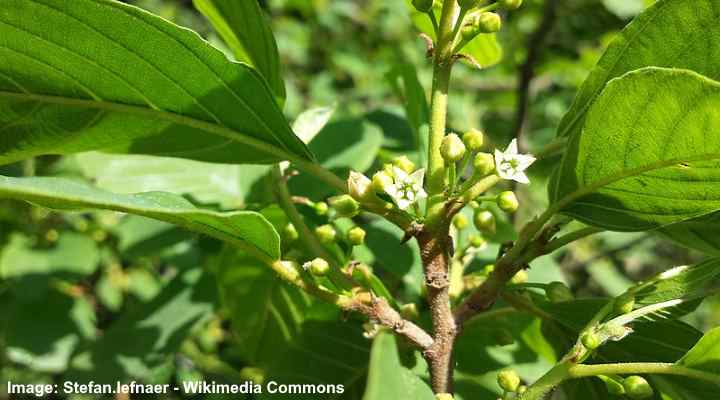
Glossy buckthorn flowers are tiny, creamy white-green, star-shaped blossoms growing in small clusters but sometimes growing solitary. These small flowers are typically found in the leaf axils—where the stems and leaves join. The buckthorn flowers measure 0.25” (6 mm) across and are typically insignificant when blooming in spring.
Buckthorn Fruit
Fruits on glossy buckthorn shrubs are small, round, berry-like drupes growing in clusters. The berries ripen from red-burgundy to purple-black. Like the common buckthorn, the berries are toxic, globoid in shape, and measure 0.25” (6 mm) across. It’s advisable to avoid eating the glossy berries.
Buckthorn Roots
Glossy buckthorn has an extensive fibrous root system that spreads aggressively. The roots are fairly shallow and send up suckers around the plant. This causes glossy buckthorn to grow into dense thickets. The fibrous root system and large number of seeds make the plant challenging to eradicate from landscapes.
How to identify glossy buckthorn
Glossy buckthorn is identified by its oval, tough, leathery leaves with smooth, toothless margins. The suckering shrub has greenish-white flowers and small, round berries that change color from bright red to dark purplish-black as they ripen. Unlike common buckthorn, Rhamnus frangula has smooth branches that lack thorns.
Fine Line Fern Leaf Buckthorn (Rhamnus frangula ‘Ron Williams’)
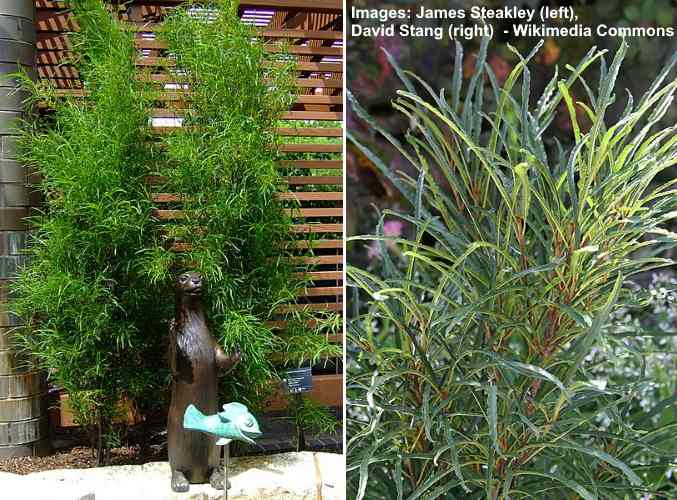
Fine line fern leaf buckthorn is a small, slow-growing shrub identified by its delicate, fern-like foliage. The shrub produces clusters of whitish-green flowers that bloom in May and June. Purple-black inedible berries appear in late summer. The feathery foliage turns yellow in the fall.
This compact and upright shrub grows 5 to 7 ft. (1.5 – 2.1 m) tall and 2 ft. (1 m) wide. Despite being an introduced variety, this buckthorn cultivar is non-invasive. Its seeds are “non-viable,” and the shrub doesn’t spread uncontrollably. These features make the glossy buckthorn cultivar ‘Rons Williams’ a useful landscaping shrub in North America.
The fine, feathery leaves of the buckthorn ‘Ron Williams’ create an elegant and airy texture in the garden. The shrub is a great addition to mixed borders, foundation plantings, hedge, screening, container plant, or as a focal point in a sunny landscape.
This low-maintenance shrub is suitable for growing in USDA zones 3 to 7. It is tolerant of a wide range of soil conditions and is highly resistant to pests and diseases.
Buckthorn Branches
The branches on the glossy buckthorn cultivar ‘Ron Williams’ are slender and upward growing with a columnar habit. The thin, reddish branches are densely covered in feathery foliage.
Buckthorn Leaves
The ‘Ron Williams’ buckthorn is famed for its light and airy fern-like foliage. The leaves are linear, smooth with a wavy effect, deeply cut, and feathery. They have a medium green color that complements their overall appearance. During the fall, the leaves of this cultivar turn a beautiful shade of yellow, adding a touch of vibrancy to any landscape.
Buckthorn Flowers
The buckthorn cultivar ‘Ron Williams’ flowers are small and greenish-yellow, measuring about 0.25” (6 mm) in diameter. The flowers are not prominent but bloom in spring and attract bees and pollinators to garden landscapes.
Buckthorn Fruit
The buckthorn cultivar ‘Ron Williams’ drupe-like berries are small, glossy, and black. The small berries measure 0.25” (6 mm) and are round, containing two to four seeds each. Unlike other introduced buckthorn species, the seeds don’t germinate easily, making this cultivar one of the least invasive buckthorn varieties.
Buckthorn Roots
Like the alder buckthorn and common buckthorn, the ‘Ron Williams’ cultivar has a fibrous root system. The network of shallow roots absorbs water and nutrients from the upper soil layers.
How to identify fine line fern leaf buckthorn
Fine line buckthorn ‘Ron Williams’ is identified by its finely cut foliage that creates a wispy, delicate appearance. It has a columnar growth habit and produces inconspicuous creamy star-shaped spring flowers. Its highly ornamental foliage turns yellow in the fall.
California Buckthorn / Coffeeberry (Rhamnus californica)
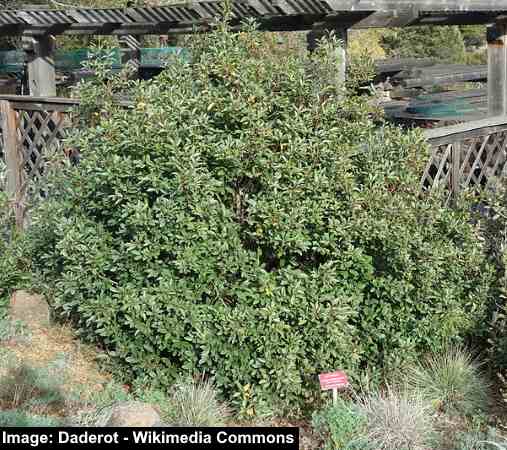
California buckthorn is a versatile shrub identified by its upright habit, small yellow-green flowers, and ovate or elliptical leaves with pronounced veining. Native to the United States, this buckthorn has a low-growth habit and grows 6 to 15 ft. (1.8 – 4.5 m) tall and wide.
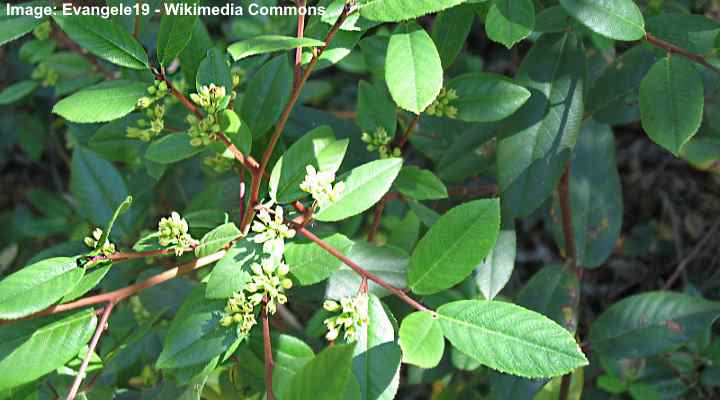
California buckthorn leaves and flowers
The shrub’s branches are dark red, producing green leaves 1” to 3” (25 – 75 mm) long. After the inconspicuous five-petalled flowers have finished, lime green berries appear that turn red and then purplish-black. The evergreen or semi-evergreen shrub is prized for its colorful stems and attractive foliage.
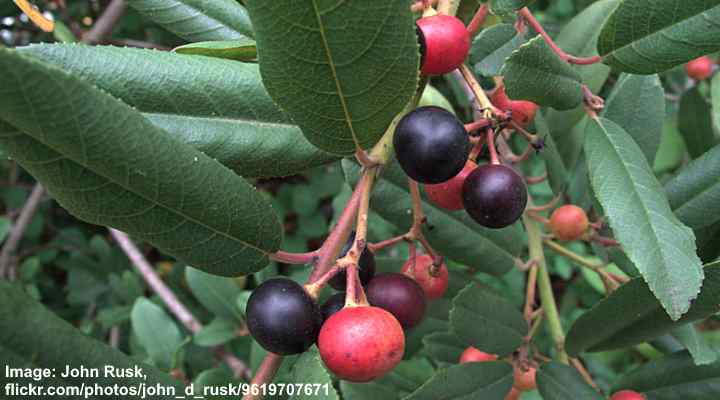
California buckthorn fruit
Also called California coffeeberry, this buckthorn variety thrives in USDA zones 7 to 9, in full sun or partial shade, and is exceedingly drought tolerant.
You can plant the low, spreading shrub as a privacy hedge, or an accent plant. It’s a great choice for native gardens, wildlife habitats, or as a low-maintenance landscape plant.
Cascara Buckthorn (Rhamnus purshiana)

Cascara buckthorn is a large shrub or small tree with deciduous, oval leaves featuring dark pinnate veins. Identifying features of the cascara buckthorn are its silver-gray splotchy bark, tiny flowers with greenish-yellow petals, and deep purple or black fruits. This deciduous shrub grows 15 to 40 ft. (4.5 – 12 m) tall.
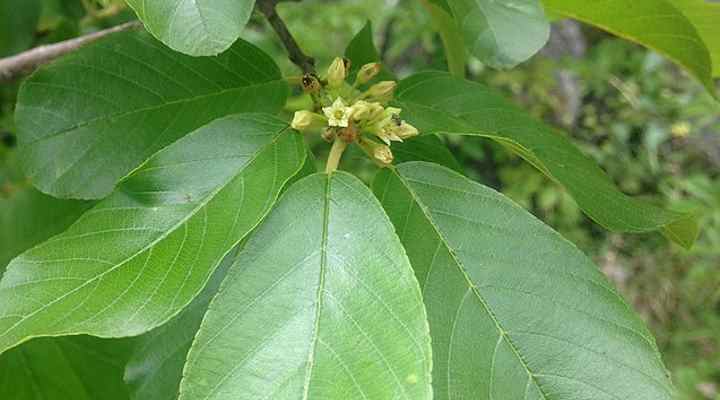
Cascara buckthorn leaves and flowers
Native to North America, the cascara buckthorn features wine-red stems.
Cascara buckthorn oval leaves measure 2” to 16” (50 to 150 mm) long and up to 2” (50 mm) wide. Like many buckthorn species, the leaves feature pronounced veins that curve upward toward the margins. The flowers are followed by small red berries that become purple-black when ripe and measure 0.40” (10 mm).

Cascara buckthorn fruit
Cascara buckthorn is often used as a hedge or screening plant in gardens in the Northwestern United States. It can grow as a multi-stemmed shrub, or you can prune its suckers to train it as a small ornamental buckthorn tree.
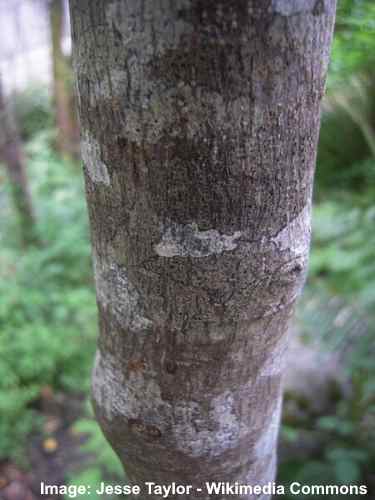
Cascara buckthorn bark
Cascara buckthorn is suitable for growing in USDA zones 3 to 8. It prefers well-drained soil and can tolerate a wide range of soil conditions, including sandy, loamy, or clay soils.
Carolina Buckthorn (Rhamnus caroliniana)
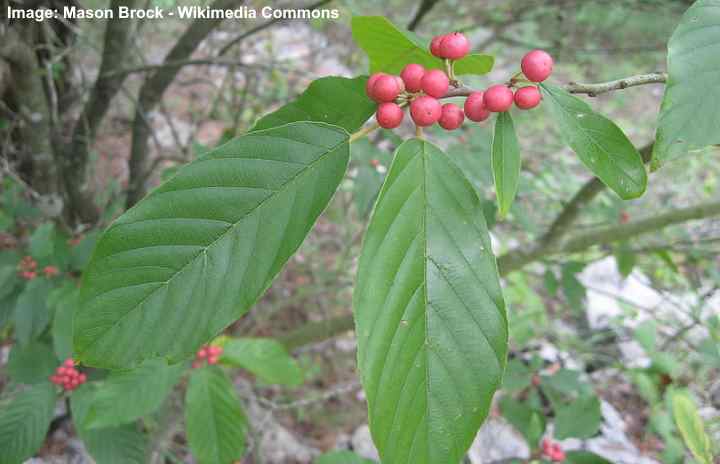
Carolina buckthorn leaves and immature fruit
Carolina buckthorn is a deciduous shrub or small tree identified by its glossy, dark green leaves, small, inconspicuous flowers, and clusters of glossy black fruits. The native shrub has coppery-brown branches, smooth, gray-grown bark, and yellow-green flowers. It grows 12 to 20 ft. (3.6 – 6 m) tall.
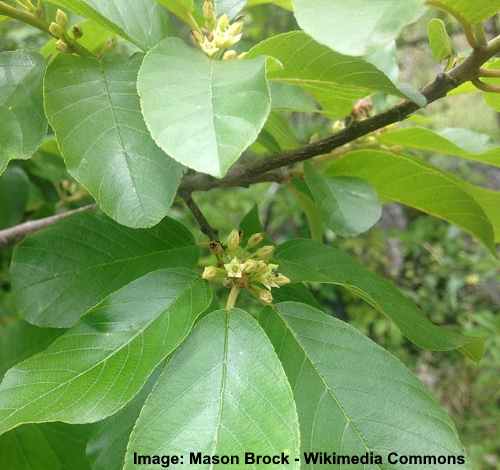
Carolina buckthorn flowers
Carolina buckthorn leaves are an ovate, elliptical shape measuring 3” to 6” (75 – 150 mm) long and up to 3” (75 mm) wide. They have a pointed tip and a tapered or rounded base. In the fall, the shrub’s foliage turns a golden yellow color.
Carolina buckthorn berries are small fleshy drupes that emerge red and turn black when ripe in late fall and early winter. The clusters of berries contain toxins that have a severe laxative effect when ingested.
The Carolina buckthorn shrub is hardy in USDA zones 5 through 9. It is low maintenance in garden landscapes and requires minimal pruning or care.
Alderleaf Buckthorn (Rhamnus alnifolia)
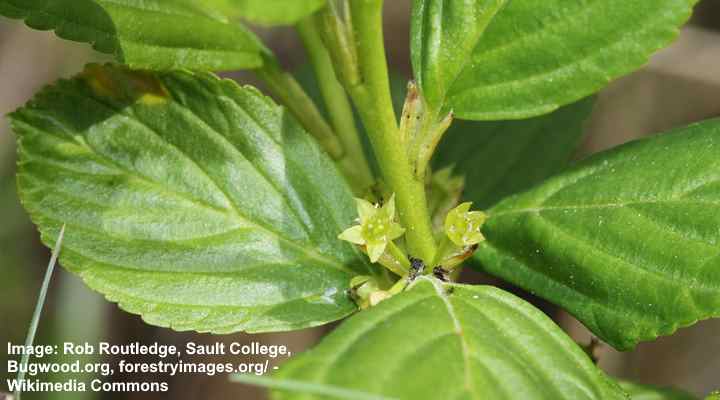
Alderleaf buckthorn leaves and flowers
Alderleaf buckthorn is a dwarf shrub, identified by its large leaves with rounded serrated margins, small yellowish-green flowers, and clusters of shiny, jet-black berries. Native to North America, the small deciduous shrub grows 3 to 6 ft. (1 – 1.8 m) tall and wide and thrives in partial to full shade.
Alderleaf buckthorn leaves are oblong with rounded teeth along the edges. The leaves are 2” to 4.5” (50 – 114 mm) long and up to 2.25” (57 mm) wide. The lanceolate leaves have the characteristic deep veining patterns of all buckthorn shrubs.
Alderleaf buckthorn “berries” are small black drupes that are 0.31” (8 mm) in diameter.
Also called dwarf alderleaf buckthorn, this versatile shrub can be used in various landscape settings. It can be planted as a hedge, screen, or in mixed borders. The shrub is also a favorite among wildlife, attracting birds with its berries.
Alderleaf buckthorn is suitable for growing in USDA zones 3 to 7.
Sea Buckthorn (Hippophae rhamnoides)
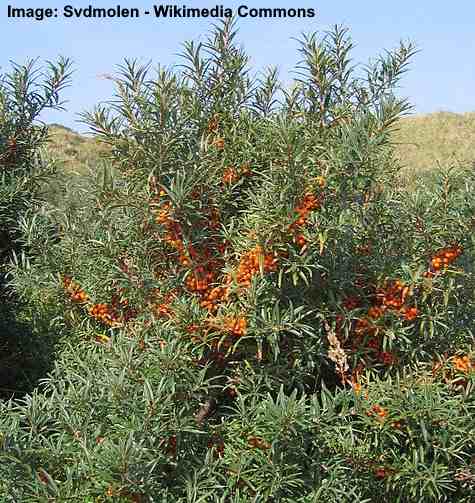
Sea buckthorn is a hardy, spiny deciduous shrub famed for its bright orange berries and silver-green foliage. It has rough brown or black bark, narrow, lanceolate leaves, and inconspicuous green flowers on its thorny stems. The cold-tolerant shrub thrives in coastal areas, growing 7 to 13 ft. (2 – 4 m) tall.
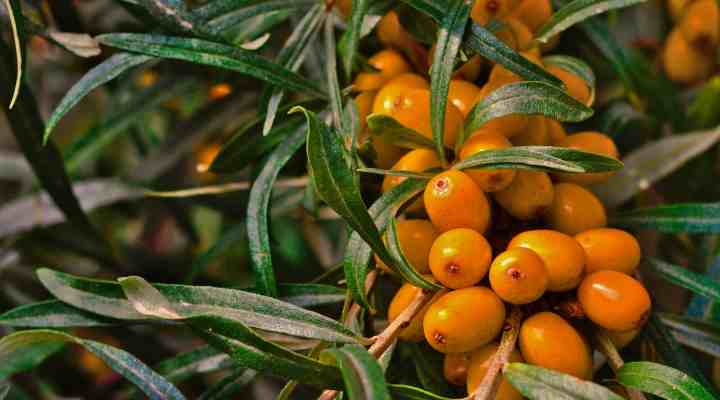
A close up picture of sea buckthorn leaves and fruit
Sea buckthorn shouldn’t be confused with common buckthorn (Rhamnus spp.) as the shrubs are from different families.
Sea-buckthorn berries are the shrub’s outstanding feature. Masses of deep orange berries cover the thorny shrub. Unlike common buckthorn berries, the small, round orange fruits are edible but have a tart, astringent taste.
These shrubs are suitable for planting in USDA zones 3 to 7 and require well-drained soil. They are also tolerant of salt spray and can withstand harsh coastal conditions.
Are All Buckthorn Berries Toxic to Humans?
Yes, the berries of most buckthorn species, including common buckthorn and glossy buckthorn, are toxic to humans when ingested. They can cause stomach cramps, diarrhea, and other gastrointestinal discomfort. It’s essential to avoid consuming these berries.
How Can I Control Invasive Buckthorn Species in My Garden or Natural Area?
Controlling invasive buckthorn species involves methods such as mechanical removal (cutting and pulling), herbicide application, and planting native alternatives. Timing is crucial, and it’s best to remove buckthorn during the fall or winter when they are still green and easier to identify.
Can I Grow Buckthorn Plants as Ornamentals in My Garden?
Some buckthorn species, such as common buckthorn and glossy buckthorn, are not recommended for ornamental use due to their invasive nature and toxicity. However, there are non-invasive buckthorn varieties, like fine line fern leaf buckthorn, that can be used as ornamental shrubs.
Do Buckthorn Plants Have Any Ecological Benefits?
While certain buckthorn species can be invasive and harmful to native ecosystems, they can also serve as habitat and food sources for some wildlife, particularly birds that feed on their berries. However, the negative impact of invasive buckthorns on native vegetation often outweighs these benefits.
Can Buckthorn Plants Thrive in Different Climate Zones?
The suitability of buckthorn plants varies by species. Common buckthorn, for example, thrives in USDA zones 3 to 7, while glossy buckthorn is suitable for zones 2 through 7. It’s crucial to select buckthorn species that are appropriate for your specific climate and region.
Related articles:
